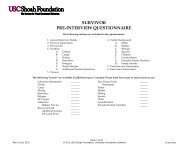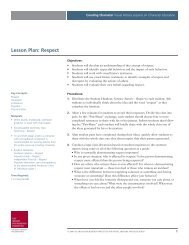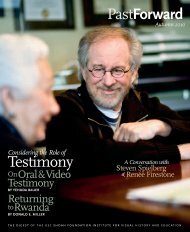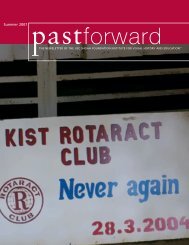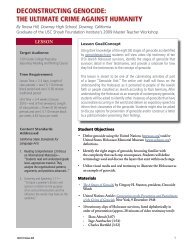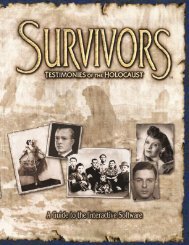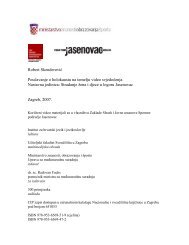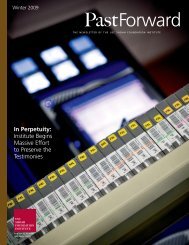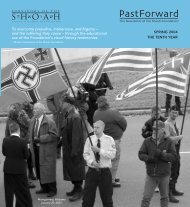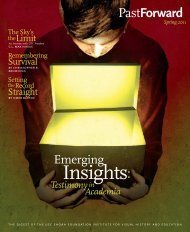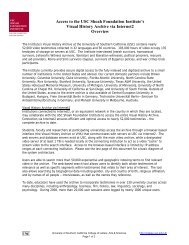Winter 2006 - USC Shoah Foundation - University of Southern ...
Winter 2006 - USC Shoah Foundation - University of Southern ...
Winter 2006 - USC Shoah Foundation - University of Southern ...
Create successful ePaper yourself
Turn your PDF publications into a flip-book with our unique Google optimized e-Paper software.
V ISUAL H ISTORY IN THE C LASSROOM<br />
Educational Initiatives Around the World<br />
HUNGARY– A new Holocausteducation<br />
kit designed specifically<br />
for Hungarian students reached<br />
every secondary school in Hungary at the<br />
beginning <strong>of</strong> the 2005-06 school year.<br />
Looking Towards the Future Through the Eyes<br />
<strong>of</strong> the Holocaust—An Educational Package for<br />
Hungarian Schools consists <strong>of</strong> the <strong>Shoah</strong><br />
<strong>Foundation</strong>’s Hungarian-language documentary<br />
Eyes <strong>of</strong> the Holocaust on DVD; Gyula<br />
Hosszú’s Roads to the Holocaust: stories about<br />
the Holocaust, a nationally recognized scholarly<br />
book; and Approaches… a comprehensive<br />
teacher’s guide that helps educators with<br />
context on how to use the film and the book<br />
in a classroom setting.<br />
Looking Towards the Future… is the result<br />
<strong>of</strong> the combined efforts <strong>of</strong> the <strong>Shoah</strong><br />
<strong>Foundation</strong>, the Hungarian Association <strong>of</strong><br />
History Teachers, and the Hannah Arendt<br />
Association.<br />
“A lot <strong>of</strong> books, films, or documentaries<br />
about the Holocaust are being used in<br />
schools in Hungary,” says Ms. Luca Illy, the<br />
<strong>Shoah</strong> <strong>Foundation</strong>’s regional representative in<br />
Hungary, “but teachers have to design their<br />
own lessons or curriculum around them.<br />
Until now, they didn’t have access to<br />
resources that were created specifically for<br />
classroom use.”<br />
László Miklósi, president <strong>of</strong> the<br />
Hungarian Association <strong>of</strong> History Teachers,<br />
conceived <strong>of</strong> and initiated the idea for the<br />
kit. “Visual media and personal experiences<br />
are basic and definitive elements in educational<br />
practice,” he says. “That is why it was<br />
important that [the visual history testimonies<br />
in] Eyes <strong>of</strong> the Holocaust be part <strong>of</strong> the kit.”<br />
“But nothing is usable and applicable in<br />
education,” Mr. Miklósi adds, “if there is no<br />
appropriate didactic and methodological help<br />
<strong>of</strong>fered to educators. The real goal <strong>of</strong> the<br />
study guide is to help teachers create their<br />
vision and their own approach to thinking<br />
and teaching about this topic.”<br />
The Task Force for International<br />
Cooperation on Holocaust Education,<br />
Remembrance, and Research and the<br />
Hungarian Ministry <strong>of</strong> Education provided<br />
the financial support for this project.<br />
“I hope that Hungarian educators will<br />
first <strong>of</strong> all think about the role and importance<br />
<strong>of</strong> Holocaust education,” states Mr.<br />
Miklósi, “and then, while teaching, use various<br />
tools that are appropriate to students'<br />
interests and needs. This is essential, as it<br />
gives students a complete picture <strong>of</strong> what<br />
happened in the past—how and why—but,<br />
most importantly, because it prepares them<br />
to think critically and react to what is happening<br />
today: acts <strong>of</strong> intolerance, hatred,<br />
and antisemitism.” ■<br />
AUSTRIA– The Austrian organization<br />
Nationalsozialismus und<br />
Holocaust: Gedächtnis und<br />
Gegenwart (National Socialism and the<br />
Holocaust: Remembrance and the Present) is<br />
producing a Holocaust—and tolerance—education<br />
DVD that will center on visual history<br />
testimonies from the <strong>Shoah</strong> <strong>Foundation</strong><br />
archive. A team <strong>of</strong> three experts—Markus<br />
Barnay, a film editor; History Pr<strong>of</strong>essor Albert<br />
Lichtblau; and Ph.D. candidate Maria Ecker<br />
—spent a week at the <strong>Shoah</strong> <strong>Foundation</strong> in<br />
Los Angeles to search the archive and identify<br />
testimonies from Austrian survivors and other<br />
witnesses, such as Jehovah’s Witnesses, political<br />
prisoners, and Sinti and Roma survivors.<br />
“Students are used to visual information<br />
today,” says Mr. Barnay, “and we think it’s a<br />
good way to engage them not just in terms <strong>of</strong><br />
learning, but also emotionally. These are real<br />
living people who tell about their own lives.<br />
This pilot is going to help us determine what<br />
the best educational approach is, and what the<br />
best use <strong>of</strong> testimonies is, both for teachers and<br />
for students.”<br />
The pilot DVD has been financed by the<br />
National Fund <strong>of</strong> the Republic <strong>of</strong> Austria for<br />
Victims <strong>of</strong> National Socialism and by the<br />
Austrian Ministry <strong>of</strong> Education, Science, and<br />
Culture. Additional funding will be needed to<br />
finalize the DVD and distribute it to secondary<br />
schools in Austria.<br />
“We want to facilitate the transmission <strong>of</strong><br />
the experiences <strong>of</strong> survivors and other witnesses<br />
to the coming generations,” says<br />
National Socialism and the Holocaust:<br />
Memory and Present director Dr. Werner<br />
Dreier, “and we hope that this DVD has an<br />
impact on public memory and education in<br />
Austria. We anticipate more public funding<br />
to come from Austria, but we still<br />
need additional support, and we are<br />
actively looking for private or corporate<br />
sponsorships to help our project come<br />
to fruition.” ■<br />
Far left: Students at Budapest’s Alternative<br />
Secondary School <strong>of</strong> Economics (Alternatív<br />
Közgazdasági Gimnázium) watch the <strong>Shoah</strong><br />
<strong>Foundation</strong>’s documentary Eyes <strong>of</strong> the<br />
Holocaust as part <strong>of</strong> a lesson from the new<br />
educational kit Looking Towards the Future<br />
Through the Eyes <strong>of</strong> the Holocaust<br />
Center: (L to R) Eyes <strong>of</strong> the Holocaust<br />
director Janos Szasz, Hungarian minister <strong>of</strong><br />
education, Bálint Magyar, Steven Spielberg,<br />
and Douglas Greenberg<br />
Above: Dr. Markus Barnay, journalist and<br />
editor; Dr. Albert Lichtblau, <strong>University</strong> <strong>of</strong><br />
Salzburg and Dr. Maria Ecker, historian,<br />
research testimonies at the <strong>Shoah</strong> <strong>Foundation</strong><br />
Recovering Names<br />
…Memorializing Lives<br />
When the Central Database <strong>of</strong> <strong>Shoah</strong><br />
Victims’ Names was uploaded onto the Yad<br />
Vashem website, www.yadvashem.org, in<br />
November last year, Yad Vashem announced<br />
an International 11th Hour Campaign to<br />
recover as many additional names <strong>of</strong><br />
Holocaust victims as possible, before the<br />
generation that best remembers them passes.<br />
An urgent call for volunteers to<br />
implement grass-roots campaigns is now<br />
being issued to Jewish communities and<br />
organizations worldwide.<br />
The <strong>Shoah</strong> <strong>Foundation</strong> has partnered with<br />
Yad Vashem in the mission to preserve the<br />
legacies <strong>of</strong> both victims and survivors <strong>of</strong> the<br />
Holocaust by providing access to its 52,000-<br />
testimony archive by 2008 at the new Visual<br />
Center at Yad Vashem (one hundred testimonies<br />
are currently available to view at the<br />
Center). At the same time, the <strong>Shoah</strong><br />
<strong>Foundation</strong> urges everyone to join the campaign<br />
to recover the names and identities<br />
<strong>of</strong> those who did not survive and have yet to<br />
be registered in Yad Vashem’s online<br />
Database.<br />
Experienced interviewers and volunteers—and<br />
anyone committed to ensuring<br />
that no Holocaust victim is forgotten—would<br />
be a significant asset to this endeavor. With<br />
the aid <strong>of</strong> promotional materials developed<br />
by Yad Vashem, volunteers will reach out to<br />
survivors and their families and assist them<br />
in registering the names <strong>of</strong> men, women,<br />
and children who they know were murdered<br />
in the <strong>Shoah</strong>.<br />
To request a free guide and resource<br />
pack to initiate a names project in your<br />
community, please send an email with the<br />
subject heading “names campaign” to<br />
names.outreach@yadvashem.org.il ■<br />
Survivors <strong>of</strong> the <strong>Shoah</strong> Visual History <strong>Foundation</strong> ® www.vhf.org pastforward, <strong>Winter</strong> <strong>2006</strong> 7



